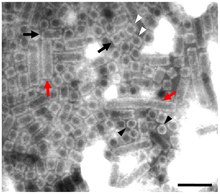Abalone shriveling syndrome-associated virus
| Abalone shriveling syndrome-associated virus | |
|---|---|

| |
| Abalone shriveling syndrome-associated virus particles are shown from the side view as long flexible/rigid rectangles (red arrows) and short rectangles (black arrows). The circles (black arrowheads) and cubes (white arrowheads) from the top view and side views, respectively, are all similar to typical hemocyanin architectures. Scale bar, 100 nm | |
| Virus classification | |
| (unranked): | Virus |
| Virus: | Abalone shriveling syndrome-associated virus
|
Abalone shriveling syndrome-associated virus was described in 2010 from an abalone which had died from abalone shriveling syndrome.[1]
Taxonomy
[edit]While the ICTV does not include the Abalone shriveling syndrome-associated virus or the Abalone muscle atrophy virus, as of August 13, the NCBI puts it under the Caudoviricetes class as an unclassified virus.[2][3] Disclaimer: The NCBI taxonomy database is not an authoritative source for nomenclature or classification of viruses.
Genome
[edit]The genome is double stranded circular DNA with 34,952 base pairs and encodes 28 putative open reading frames. The G+C content of the genome is 39.5%. The functions of several of these proteins is known: these include the terminase, endonuclease, exonuclease, resolvase, helicase, primase and single-stranded binding protein. Seven other proteins appear to be structural in nature (head/tail proteins). Another protein encoded by the genome is thymidylate kinase. The remaining proteins have no known homologs and their function remains unknown.[citation needed]
Virology
[edit]The disease caused by this virus was first noted in cultivated abalone in China in 1999. Since then there has been an epidemic of continuous outbreaks of this disease.[citation needed]
The virus is spread in the water. It is released from the dead or dying abalones and ingested by the abalone while feeding.[citation needed]
References
[edit]- ^ Zhuang J, Cai G, Lin Q, Wu Z, Xie L (2012) A bacteriophage-related chimeric marine virus infecting abalone. PLoS One 5(11):e13850. doi:10.1371/journal.pone.0013850
- ^ "Virus Taxonomy: 2022 Release". International Committee on Taxonomy of Viruses (ICTV). March 2023. Retrieved 13 August 2023.
- ^ "Taxonomy browser (Abalone shriveling syndrome-associated virus)". National Center for Biotechnology Information (NCBI). Retrieved 13 August 2023.
